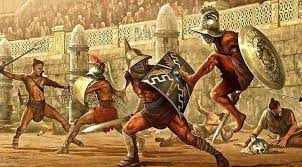Vaša košarica je trenutno prazna!
Introduction
The image of two bloodthirsty gladiators locked in a life-or-death struggle is deeply rooted in modern pop culture. From movies like Gladiator to TV shows and documentaries, we’re led to believe that every Roman arena match ended in a brutal death.
But is this really how it happened? Were gladiators always expected to kill or be killed? The reality is far more complex — and surprisingly humane in certain contexts.
Gladiator Games in Ancient Rome
Gladiator contests were part of public festivals and political events in ancient Rome, especially from the 1st century BCE onward. Held in massive amphitheaters like the Colosseum, these spectacles drew tens of thousands of spectators.
However, not all matches were intended to be deadly. The majority of gladiators were slaves, criminals, or prisoners of war, but they were also highly trained professionals — valuable investments for their owners.
Death Was Possible — But Not Always Expected
Historical records and inscriptions show that most matches did not end in death. In fact, evidence suggests that only around 10–20% of bouts were fatal. Gladiators were expensive to train and maintain. Their deaths represented a financial loss, especially if they had potential for future profit.
Combatants could surrender, and referees often stopped fights before death occurred.
The Role of the Crowd and the Emperor
The decision to spare or kill a defeated gladiator often lay in the hands of the editor — usually a wealthy sponsor or even the emperor. The crowd could influence the outcome with chants and gestures, but ultimately, it was a calculated choice.
If the defeated gladiator had fought bravely, he was likely spared. Cowardice or dishonor might lead to a death sentence, but mercy was not uncommon.
Ancient Sources and Misconceptions
Writers like Seneca, Cicero, and Juvenal describe gladiator fights with nuance — emphasizing skill, bravery, and discipline rather than constant bloodshed.
Modern misconceptions likely stem from sensationalized medieval accounts and Hollywood exaggerations. The image of a kill-or-be-killed arena was more myth than everyday reality.
Pop Culture vs. Historical Reality

Films often dramatize the blood and violence of the arena, but real Roman gladiatorial games were more regulated and structured. Fights followed strict rules, and not all combatants were expected to die.
Some gladiators even became celebrities, with fan followings and merchandise (graffiti with their names, souvenirs, etc.).
Gladiators as Athletes
In many ways, gladiators were the professional athletes of their time. They trained in specialized schools (ludi), had diets tailored for performance, and were treated for injuries by on-site physicians. Their survival was essential to the entertainment industry of Rome.
Like modern sports, the goal was to entertain — not to execute.
Conclusion: Myth or Truth?
So, did gladiators always die in the arena? No — that’s a myth.
While death was a real and ever-present risk, it was not the guaranteed outcome of every fight. Many gladiators fought multiple times and even won their freedom. The arena was brutal, but it was also a business, and death wasn’t always profitable.
Explore more historical war machines on our Legends and Myths site.

